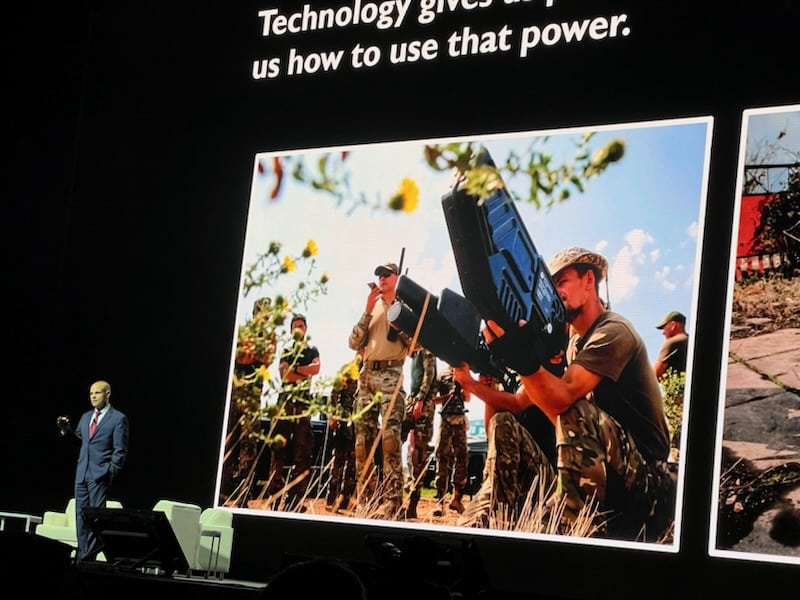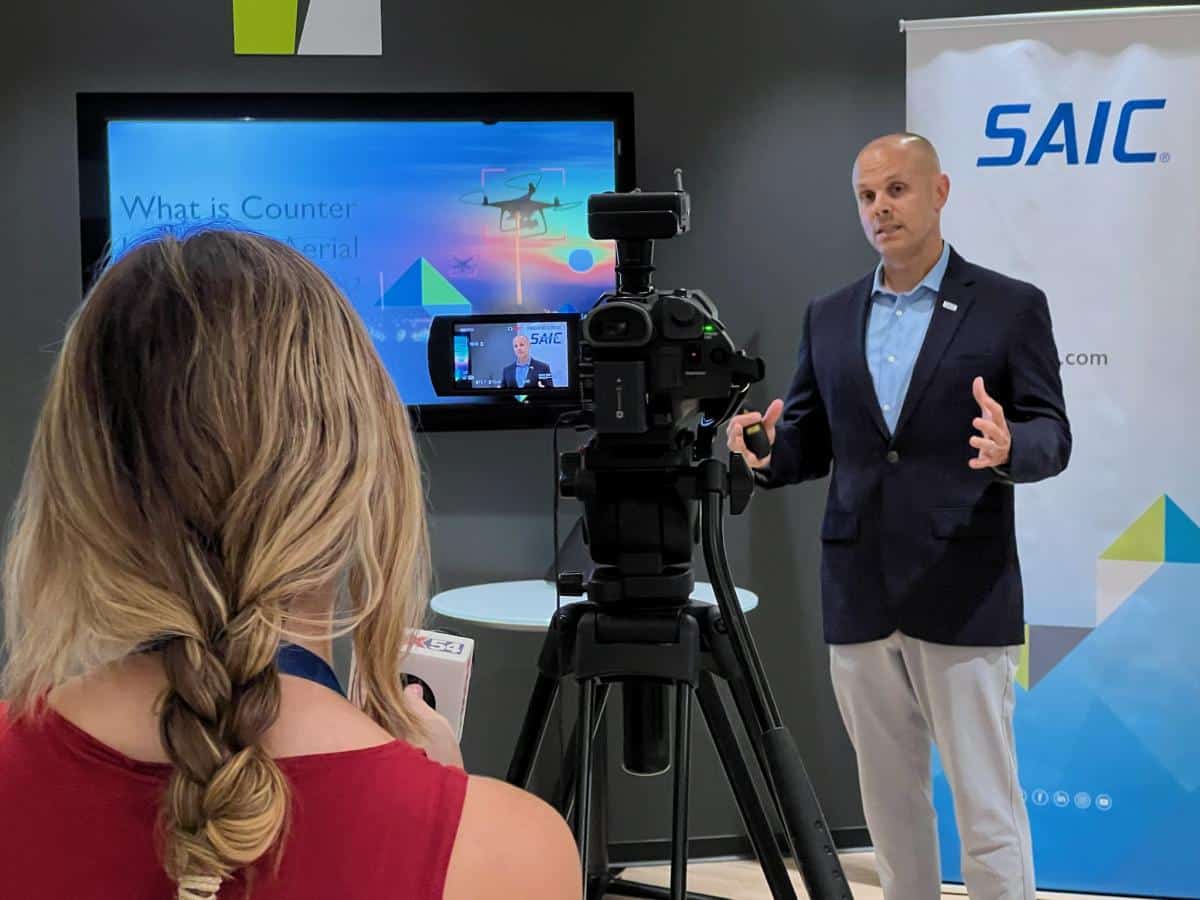SAIC Integrates World Class UAS Technology, Seeks Partners
July 11, 2023 | Dawn Zoldi

As the use of drones continues to grow, so too does the risk of harm from drones to military forces and critical infrastructure globally. In this interview, SAIC’s Billy Jackson, Business Development Director, discusses how SAIC, a leading technology integrator for a broad range of higher-end, differentiated technical capabilities, provides full life-cycle counter-uas (CUAS) services and solutions, to serve a wide range of customers across U.S. federal government, state/local, and global commercial markets. Read on to better appreciate the history, context and current posture of SAIC’s CUAS technology offerings and ecosystem for government and commercial projects that support the warfighter, critical infrastructure and other customers that require best-in-breed CUAS solutions.
Dawn Zoldi: Billy, tell us a little about yourself.
Billy Jackson: Sure. I spent 28 years as an active duty Army officer. The first 12 of those years, I flew Black Hawks and led the troops that also flew them. I spent the last portion of my career as an acquisition officer leading Army Aviation programs, most notably the Blackhawk helicopter and some smaller classified aviation-related programs. I’ve spent about two and a half years here at SAIC’s Army Business Unit in Huntsville, Alabama, learning about counter-UAS (CUAS) technology and how we can do a better job serving the needs of our customers.
Dawn Zoldi: From the 30,000 foot view, what does SAIC do?
Billy Jackson: SAIC is a premier, global 24,000-personnel strong Fortune 500® major technology systems integrator, headquartered in Virginia. Our robust portfolio of offerings across the defense, space, civilian and intelligence markets includes secure high-end solutions in engineering, digital, artificial intelligence and mission solutions. Using our expertise and understanding of existing and emerging technologies, we integrate the best components from our own portfolio and our partner ecosystem to deliver innovative, effective and efficient solutions that are critical to achieving our customers’ missions. We are primarily a government support contractor, with a long history of doing systems integration with Army, Air Force and Navy platforms. We do a lot of work in the civilian sector as well.
Dawn Zoldi: Before we get into SAIC’s CUAS solutions, can you provide your assessment of the risk that drones present to critical infrastructure?
Billy Jackson: Sometimes we’re uncomfortable talking about that, but I think we have to take those blinders off and have discussions about where our vulnerabilities are and what the actual threats could be. Think about large events. For example, down here in Alabama, SEC football is king every Saturday. During football season, in Tuscaloosa, that stadium’s full of 110,000 people. It wouldn’t take much to cause a significant loss of life, even secondarily from a drone event, whether by trampling or whatever. Think about a drone knocking out power for a few days. That could affect revenue, commerce and the freedoms of the American people. Then there’s espionage. A bad actor could land a drone on a roof of a building and, using various sensors, listen in to what’s happening either electronically or audibly. The risks are only limited to your imagination.
Dawn Zoldi: How have you seen the drone risk change over time?
Billy Jackson: I like to use a sort of a story to baseline this. In Iraq and Afghanistan, we initially saw the development of very crude improvised explosive devices (IEDs). In short order, the delivery systems for those devices became more sophisticated, using pressure plate devices and cell phone-controlled detonation devices. Then they started delivering IEDs by air, using drones. Those wreaked havoc on our operations. We lost a lot of service members to IEDs. It significantly changed the way that we fought. We had to develop sophisticated counter IED technology and equipment to address constantly evolving threats.
Dawn Zoldi: So, how did SAIC get involved in offering CUAS technologies?
Billy Jackson: At SAIC, we have a history spanning five decades in the field of fires, aviation, and missile defense. We got into this business through the larger umbrella of force protection in Iraq and Afghanistan, such as gate security systems to provide the ability to observe, detect and neutralize particular threats. We specifically got into the CUAS business through one of our contracts for the Air Force’s Medusa program. It aimed to protect areas that the Air Force deemed high risk to drone events. We learned a lot from working with the Medusa program. Our engineers here at Huntsville still support that program. It inspired us to design a clean sheet system using open systems architecture with available innovative software and hardware. We call it the Valkyrie system.
Dawn Zoldi: Tell us more about Valkyrie.
Billy Jackson: We developed a system of systems, utilizing best-of-breed technologies to create comprehensive solutions. These include detection, tracking, rapid identification through AI and machine learning, and mitigation. We tailor our systems to the specific needs of the customer, ensuring our solutions are flexible and adaptable. We have a menu of options that we can bring to the table to support a customer’s requirements and their limitations, such as the physical or regulatory environment in which they’re operating. We bring the breast of breed sensors and effectors to create an overall integrated capability.
Dawn Zoldi: What approach does SAIC use in building out the Valkyrie system?
Billy Jackson: We take a layered system approach. First, you need to detect drones. Relevant technologies for that include radar, radio frequency (RF) signature, electro-optical and infrared (EO/IR) capabilities. Not only do you have to detect that threat, you also have to identify that threat. That’s where artificial intelligence and machine learning (AI & ML) come into play. Then you have to mitigate it. You have to wrap all of this into a holistic command and control (C2) system. To do this, we partner with a number of ecosystem vendors that bring a range of mitigation capabilities that include jamming, cyber takeover and even nets that capture the drone.
Dawn Zoldi: Who are your vendors and partners for Valkyrie?
Billy Jackson: We have a number of partner companies that contribute to our Valkyrie system and overall CUAA strategy. Right now, we have over 40 sensors and effectors that we’ve integrated, such as D-Fend Solutions, Liteye and AeroGuard. For example, AeroGuard is a system capable of launching from a fixed position, achieving airborne status within seconds, tracking an UAS, deploying a net, and then retrieving the UA. The entire process is quick and efficient due to our ability to detect, track, and identify targets via software.
Dawn Zoldi: How do companies become part of your CUAS portfolio?
Billy Jackson: We’re a large company, but we act like a small company in the way we do business. It’s all about simple conversations and direct communications. Jeremy Davidson is our lead engineer and he takes phone calls all the time, as do I. We’re at trade shows. We get business cards and follow up. We try to put deals together in terms of integrating other systems into ours. We are very open to those discussions, even if you’re a competitor with one of our existing systems. We’re constantly looking for who’s innovating, who’s evolving, who’s managing obsolescence within their portfolio and who’s working to reduce costs for the customer base. So please reach out to me directly. I’ll be happy to link you up with the team. We will definitely engage.
Dawn Zoldi: What qualities do you look for in companies, when selecting your ecosystem partners?
Billy Jackson: We select those vendors based on their openness and willingness to work with us to integrate into our system. We continuously engage vendors in this space. We’re always on the lookout for new technologies and people on the cutting edge to address the evolving threat.
Dawn Zoldi: On the flipside, who are some of your primary CUAS customers?
Billy Jackson: We have customers from civilian organizations like municipalities, other government agencies (OGAs) like Customs and Border Protection and the Army Corps of Engineers. Most people don’t think about the Corps of Engineers, but they have to manage and protect some of the infrastructure that’s critical to our nation’s commerce, such as dams.
Dawn Zoldi: Can you share some of your successes with Valkyrie?
Billy Jackson: We’ve been showcasing Valkyrie the last two years. From the start, during our first demonstration in April of 2022 at Yuma for the Joint CUAS Office (JCO), the joint agency that designs policy, doctrine and requirements for the DoD, we have been extremely successful. We were selected as one of top three systems to engage class one through three drones with different effects. We have the memorandum from the JCO to prove it. We showed them we could pinpoint the area from where they had been launching the drones and the probability of a drone attack. Our backend analytics, based on time tracks and altitudes that feed into our AI & ML made operator decision making much more effective.
We also recently won the Edison Award. That award has been around since 1987 and recognizes those folks in Industry that are really being innovative. We’re pretty excited about the Edison win because it recognized our team, those in our ecosystem and the overall enterprise that supports CUAS.
Dawn Zoldi: Do you face challenges in bringing these award-winning capabilities to the warfighter or the commercial sector?
Billy Jackson: Yes, unfortunately, we do face some challenges. On the DoD side, while there’s a lot of discussion at high level senior leadership that indicates CUAS remains their number one priority, we are not seeing appropriated dollars flow to match that vision. For our part, we continue to engage and demonstrate our capability at events like the JCO demo, to show that we are ready for the customer when they are ready to move forward. On the commercial and civil side in the U.S., restrictive laws and interpretations on CUAS remain a limiting factor for all but a handful of federal agencies
Dawn Zoldi: For those who can employ CUAS solutions, how do you offer yours to these customers?
Billy Jackson: We can offer our capability to customers who want to buy the system and the sustainment for the system. This includes foreign military sales and direct commercial sales. We also offer the capability as a service. So if the customer wanted to define a specific required service, in terms of capabilities, we would come in, set it up and run a 24/7 operation.
Dawn Zoldi: You spoke a lot about engagement, where might folks find you or other members of the SAIC CUAS-focused team?
Billy Jackson: We just supported P3 Tech Consulting’s Law-Tech Connect Workshop at AUVSI XPONENTIAL in Denver, as well as the Law-Tech Connect: Energy Edition in Houston. Next, we will be at the 2023 Association of the U.S. Army Annual Meeting and Exposition in Washington D.C. in early October. We plan to have a robust presence out there. We will have a boot, with our Valkyrie C2 system and as many sensors and effectors as we can put in it. So please come by and see us. After that, our next event will be SAE Media Group’s CUAS Conference in Crystal City, Virginia in December. You can also find out more about us at https://www.saic.com/cuas.

Watch Billy Jackson on the Dawn of Drones podcast: https://www.youtube.com/watch?v=ZI7Oyb55bvU


